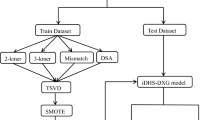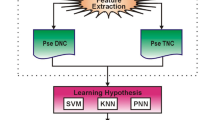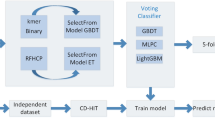Abstract
DNase I hypersensitive sites (DHSs) are hallmarks of chromatin zones containing transcriptional regulatory elements, making them critical in understanding the regulatory mechanisms of gene expression. Although large amounts of DHSs in the plant genome have been identified by high-throughput techniques, current DHSs obtained from experimental methods cover only a fraction of plant species and cell processes. Furthermore, these experimental methods are both time-consuming and expensive. Hence, it is urgent to develop automated computational means to efficiently and accurately predict DHSs in the plant genome. Recently, several methods have been proposed to predict the DHSs. However, all these methods took a lot of time to build the model, making them inappropriate for data with massive volume. In the present work, a new ensemble extreme learning machine (ELM)-based model called pDHS-ELM was proposed to predict the DHSs in the plant genome by fusing two different modes of pseudo-nucleotide composition. Here, two kinds of features including reverse complement kmer and pseudo-nucleotide composition were used to represent the DHSs. The ELM model was used to build the base classifiers. Then, an ensemble framework was employed to combine the outputs of these base classifiers. When applied to DHSs in Arabidopsis thaliana and rice (Oryza sativa) genome, the proposed method could obtain accuracies up to 88.48 and 87.58%, respectively. Compared with the state-of-the-art techniques, pDHS-ELM achieved higher sensitivity, specificity, and Matthew’s correlation coefficient with much less training and test time. By employing pDHS-ELM, we identified 42,370 and 103,979 DHSs in A. thaliana and rice genome, respectively. The predicted DHSs were depleted of bulk nucleosomes and were tightly associated with transcription factors. Approximately 90% of the predicted DHSs were overlapped with transcription factors. Meanwhile, we demonstrated that the predicted DHSs were also associated with DNA methylation, nucleosome positioning/occupancy, and histone modification. This result suggests that pDHS-ELM can be considered as a new promising and powerful tool for transcriptional regulatory elements analysis. Our pDHS-ELM tool is available from the following website https://github.com/shanxinzhang/pDHS-ELM/.








Similar content being viewed by others
References
Cao J, Lin Z et al (2012) Voting based extreme learning machine. Inf Sci 185(1):66–77
Celniker SE, Dillon LAL et al (2009) Unlocking the secrets of the genome. Nature 459(7249):927–930
Chen W, Zhang X et al (2015) PseKNC-General: a cross-platform package for generating various modes of pseudo nucleotide compositions. Bioinformatics 31(1):119–120
Chen W, Tang H et al (2016) iRNA-PseU: identifying RNA pseudouridine sites. Mol Ther 5(7):e332. https://doi.org/10.1038/mtna.2016.37
Cheng X, Zhao S-G et al (2017) iATC-mISF: a multi-label classifier for predicting the classes of anatomical therapeutic chemicals. Bioinformatics 33(3):341–346
Chou K-C (2011) Some remarks on protein attribute prediction and pseudo amino acid composition. J Theor Biol 273(1):236–247
Fan YX, Shen HB (2014) Predicting pupylation sites in prokaryotic proteins using pseudo-amino acid composition and extreme learning machine. Neurocomputing 128(5):267–272
Feng P, Jiang N et al (2014) Prediction of DNase I hypersensitive sites by using pseudo nucleotide compositions. Sci World J. https://doi.org/10.1155/2014/740506
Freeling M, Subramaniam S (2009) Conserved noncoding sequences (CNSs) in higher plants. Curr Opin Plant Biol 12(2):126–132
Henikoff S, Henikoff JG et al (2009) Genome-wide profiling of salt fractions maps physical properties of chromatin. Genome Res 19(3):460–469
Huang GB, Zhu QY et al (2006) Extreme learning machine: theory and applications. Neurocomputing 70(1):489–501
Huang GB, Wang DH et al (2011) Extreme learning machines: a survey. Int J Mach Learn Cybern 2(2):107–122
Huang GB, Zhou H et al (2012) Extreme learning machine for regression and multiclass classification. IEEE Trans Syst Man Cybern Part B 42(2):513–529
Jia J, Liu Z et al (2016) pSuc-Lys: predict lysine succinylation sites in proteins with PseAAC and ensemble random forest approach. J Theor Biol 394:223–230
Jiang J (2015) The ‘dark matter’ in the plant genomes: non-coding and unannotated DNA sequences associated with open chromatin. Curr Opin Plant Biol 24:17–23
Jin C, Zang C et al (2009) H3.3/H2A.Z double variant-containing nucleosomes mark ‘nucleosome-free regions’ of active promoters and other regulatory regions. Nat Genet 41(8):941–945
Jin W, Tang Q et al (2015) Genome-wide detection of DNase I hypersensitive sites in single cells and FFPE tissue samples. Nature 528(7580):142–146
Kabir M, Yu D-J (2017) Predicting DNase I hypersensitive sites via un-biased pseudo trinucleotide composition. Chemom Intell Lab Syst 167:78–84
Lan Y, Soh YC et al (2009) Ensemble of online sequential extreme learning machine. Neurocomputing 72(13):3391–3395
Liu N, Wang H (2010) Ensemble based extreme learning machine. IEEE Signal Process Lett 17(8):754–757
Liu B, Liu F et al (2015a) Pse-in-One: a web server for generating various modes of pseudo components of DNA, RNA, and protein sequences. Nucleic Acids Res 43(W1):W65–W71
Liu G, Xing Y et al (2015b) Using weighted features to predict recombination hotspots in Saccharomyces cerevisiae. J Theor Biol 382:15–22
Liu B, Long R et al (2016) iDHS-EL: identifying DNase I hypersensitive sites by fusing three different modes of pseudo nucleotide composition into an ensemble learning framework. Bioinformatics 32(16):2411–2418
Liu Y, Tian T et al (2017) PCSD: a plant chromatin state database. Nucleic Acids Res 46(D1):D1157–D1167
Noble WS, Kuehn S et al (2005) Predicting the in vivo signature of human gene regulatory sequences. Bioinformatics 21(Suppl 1):i338–i343
Pajoro A, Madrigal P et al (2014) Dynamics of chromatin accessibility and gene regulation by MADS-domain transcription factors in flower development. Genome Biol 15(3):R41. https://doi.org/10.1186/gb-2014-15-3-r41
Qiu W-R, Sun B-Q et al (2016) iPTM-mLys: identifying multiple lysine PTM sites and their different types. Bioinformatics 32(20):3116–3123
Savojardo C, Fariselli P et al (2011) Improving the detection of transmembrane β-barrel chains with N-to-1 extreme learning machines. Bioinformatics 27(22):3123–3128
Sullivan AM, Arsovski AA et al (2014) Mapping and dynamics of regulatory DNA and transcription factor networks in A. thaliana. Cell Rep 8(6):2015–2030
Turco G, Schnable JC et al (2013) Automated conserved non-coding sequence (CNS) discovery reveals differences in gene content and promoter evolution among grasses. Front Plant Sci 4:170. https://doi.org/10.3389/fpls.2013.00170
Wang DD, Wang R et al (2014) Fast prediction of protein–protein interaction sites based on extreme learning machines. Neurocomputing 128(128):258–266
Xing P, Su R et al (2017) Identifying N(6)-methyladenosine sites using multi-interval nucleotide pair position specificity and support vector machine. Sci Rep 7:46757. https://doi.org/10.1038/srep46757
You Z-H, Lei Y-K et al (2013) Prediction of protein-protein interactions from amino acid sequences with ensemble extreme learning machines and principal component analysis. BMC Bioinform 14(8):S10. https://doi.org/10.1186/1471-2105-14-s8-s10
Zhang W, Wu Y et al (2012a) High-resolution mapping of open chromatin in the rice genome. Genome Res 22(1):151–162
Zhang W, Zhang T et al (2012b) Genome-wide identification of regulatory DNA elements and protein-binding footprints using signatures of open chromatin in Arabidopsis. Plant Cell 24(7):2719–2731
Zhang T, Marand A et al (2015) PlantDHS: a database for DNase I hypersensitive sites in plants. Nucleic Acids Res 44:D1148–D1153
Zhang S, Zhou Z et al (2017) pDHS-SVM: a prediction method for plant DNase I hypersensitive sites based on support vector machine. J Theor Biol 426:126–133
Funding
This work was supported by the Fundamental Research Funds for the Central Universities (No. JUSRP115A27).
Author information
Authors and Affiliations
Corresponding author
Ethics declarations
Conflict of interest
The authors declare that they have no conflict of interest.
Ethical approval
This article does not contain any studies with human participants or animals performed by any of the authors.
Additional information
Communicated by S. Hohmann.
Electronic supplementary material
Below is the link to the electronic supplementary material.
Rights and permissions
About this article
Cite this article
Zhang, S., Chang, M., Zhou, Z. et al. pDHS-ELM: computational predictor for plant DNase I hypersensitive sites based on extreme learning machines. Mol Genet Genomics 293, 1035–1049 (2018). https://doi.org/10.1007/s00438-018-1436-3
Received:
Accepted:
Published:
Issue Date:
DOI: https://doi.org/10.1007/s00438-018-1436-3




